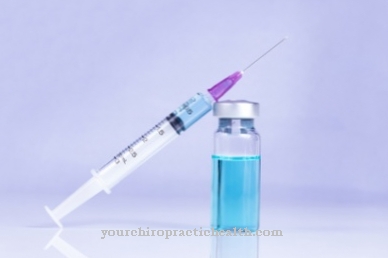At a Amniotic fluid embolism it is a dangerous complication during childbirth. Amniotic fluid is washed into the mother's bloodstream.
What is an amniotic fluid embolism?

© SianStock - stock.adobe.com
The amniotic fluid embolism is also called Amniotic Infusion Syndrome known. What is meant is a special form of embolism that occurs during the birth process. During childbirth, amniotic fluid from the uterus enters the pregnant woman's bloodstream. This causes obstruction of the capillaries or pulmonary arterioles, which in turn affects the blood clotting system.
Amniotic fluid embolism rarely occurs. However, it is usually severe and can result in death for the woman concerned. If they survive, there is a risk of brain damage in both mother and child. Amniotic fluid embolism is rare. According to estimates, the special form of an embolism occurs in only 2 to 8 cases in 100,000 births.
In 25 to 34 percent of all women affected, death occurs within the first hour. Only 16 to 20 percent survive the amniotic fluid embolism. In 70 percent of all cases, the embolism shows up during birth. 19 percent suffer the complication during a caesarean section and 11 percent during a vaginal birth. The child is also threatened by the amniotic fluid embolism. About half of all affected babies die.
causes
The exact causes of the amniotic fluid embolism have not yet been precisely determined. It is a special form of pulmonary embolism. This is due to the contact of amniotic fluid components with the mother's bloodstream. Since in most cases the rupture of the bladder occurs at the same time, some doctors suspect this as a possible trigger of the embolism.
On the other hand, there are numerous reactions that clearly exceed an ordinary embolism. In the course of the amniotic fluid embolism, the amniotic fluid can penetrate the pregnant woman's venous system through an open area in the placenta.
Sometimes, however, injuries to the cervical blood vessels or the venous plexus of the uterus are also the cause of the penetration of the amniotic fluid. The amniotic fluid penetrates from the venous system to the pulmonary arteries. It also enters the body's circulation via shunts in the lungs. The exact mechanisms that promote the development of an amniotic fluid embolism are not exactly known. In addition, not every contact between the amniotic fluid and its components and the mother's circulation results in a dangerous embolism.
There are several risk factors that can trigger an amniotic fluid embolism. This includes all diseases or processes that trigger increased labor. Typical risk factors include rupture of the bladder, uterine rupture, injuries during childbirth such as a tear in the cervix or a tear in the vagina, a caesarean section and a vaginal-operative delivery. Other possible triggers are injuries to the uterine plexus, the premature detachment of the placenta, intrauterine fetal death or the administration of contraction agents.
Symptoms, ailments & signs
The diagnosis of amniotic fluid embolism must be made quickly because of the dangerous nature of the complication. The disease initially manifests itself through signs such as breathing difficulties, tremors, feeling cold and sensory disturbances in the fingers. Affected women also experience unspecific anxiety states and an inner restlessness, often associated with nausea and vomiting.
These first signs usually appear suddenly and persist for a few minutes to four hours before the acute symptoms set in. In the early stages, the patients show symptoms such as seizures and shortness of breath with cyanosis. In addition, signs of shock such as circulatory problems or even a loss of consciousness occur. In over half of the women there is also chest pain. If this first phase is survived, bleeding occurs in the second stage and finally a hemorrhagic shock, which manifests itself among other things as dizziness and circulatory collapse and is often fatal.
In the late stages of amniotic fluid embolism, respiratory distress syndrome develops, in the course of which pulmonary edema develops. This is accompanied by hyperfibrinolysis, which often leads to multiple organ failure. The individual phases of the disease flow into one another and occur within a few hours. In the unborn child, the reduced oxygen supply leads to cardiac arrhythmias and ultimately death. At the same time, the patients usually notice unusually strong contractions.
In addition, the affected mother suffers from confusion, anxiety and cramps. Eventually she loses consciousness. You may also experience vomiting or chills. In severe cases, there is a risk of respiratory and circulatory arrest.
course
The amniotic fluid embolism has two phases: During the first phase, the arterial pulmonary flow path, for which the components of the amniotic fluid are responsible, is blocked. This results in vasoconstriction (vasoconstriction) and pulmonary hypertension. The clogging of the pulmonary vessels reduces the filling pressure and the cardiac output. This leads to cardiogenic shock.
The second phase occurs after 30 minutes to three hours. Heavy bleeding occurs due to generalized coagulation and consumption coagulopathy. The mother can therefore die from hemorrhagic shock. In addition, there is a respiratory distress syndrome including pulmonary edema. It is not uncommon for the shock to result in fatal multiple organ failure.
Complications
If the amniotic fluid embolism is not diagnosed and treatment is not given, the risk of death is 100 percent. The only way to survive - both for mother and for the newborn child - is through intensive care treatment. The diagnosis must be made very quickly. Without rapid intervention, there will be shortness of breath and shock, which in turn will lead to cardiac arrest.
Sepsis occurs when the amniotic fluid - including its solid components - enters the maternal bloodstream. This poisoning affects the entire body. Without treatment, the woman's body collapses in a very short time due to multiple organ failure. The disease itself cannot be treated, only its symptoms.
Due to decreased oxygen supply and the failure of the circulatory system as well as the immune system, neurological damage is the most common complication. This affects both the mother and the child. As a complication of the required intubation - to ensure breathing - tissue in the pharynx can be injured. Numerous drugs are administered to counteract heart failure and an immunological defense reaction.
These can produce side effects and in turn lead to organ damage. In order to increase the chances for mother and child, an emergency caesarean section is usually performed. As a complication, further bleeding of the uterus and adjustment problems (lack of breathing, cardiac arrhythmia) of the newborn can occur. If the amniotic fluid embolism develops during pregnancy and this requires an emergency caesarean section, complications can arise for the premature baby. These show up in adjustment difficulties and often in organ insufficiencies.
When should you go to the doctor?
A pregnant woman should always see a doctor if she feels that something is wrong with her or her baby. If you have a vague feeling of complications, unusual changes or fear, a doctor should be consulted for control purposes. If there are signs such as confusion, a persistent feeling of stress, malaise or general weakness, it is necessary to consult a doctor.
Repeated vomiting throughout the day or during childbirth, headaches, nausea or a strong sensation of cold are considered unusual and should be clarified. If you have chills or an elevated body temperature, a doctor is needed. If breathing is reduced, breathing stops or breathing has stopped, a doctor's visit is necessary as soon as possible.
A life-threatening condition threatens the expectant mother and the child. If you have circulatory problems, high blood pressure or a barely palpable pulse, a doctor should be called. Discoloration of the skin, swelling or other skin changes should be presented to a doctor. Blue discoloration of the skin is of particular concern. If it occurs, a doctor should be consulted immediately. If the birth takes place in an inpatient setting, the signs are usually observed by the obstetricians and immediately reported to a doctor. In the case of a home birth, the mother-to-be and those present are subject to increased due diligence and must react immediately.
Doctors & therapists in your area
Treatment & Therapy
It is not possible to treat an amniotic fluid embolism causally or specifically. Symptomatic intensive care therapy is usually carried out. The aim is to stabilize the affected mother's condition. For most patients, the doctor in charge inserts a hollow plastic probe through their nose or mouth.
From there he places the probe in the windpipe to ensure artificial ventilation. The patient is given an infusion to counter the drop in blood pressure. She is also given drugs that prevent right heart failure. Glucocorticoids are also administered.
If the patient's condition can be stabilized, a vaginal delivery can be carried out. If, on the other hand, there is no improvement after about five minutes, an emergency caesarean section must be carried out to save the child. This increases the mother's chances of cardiopulmonary resuscitation.
After the child is born, the mother is given the hormone oxytocin as an infusion to prevent atonic rebleeding. The oxytocin is mostly combined with the ergot alkaloid methylergometrine. These medicines can help the uterus to contract, which helps reduce bleeding.
Outlook & forecast
The point in time when the pregnant woman receives interdisciplinary care is decisive for making a prognosis. With a quick diagnosis and immediate extensive medical treatment, the health of the expectant mother can be stabilized. There is a good prognosis for both the mother and the child.
However, the more time passes, the more likely a life-threatening condition will occur. The pregnant woman is threatened with shock, shortness of breath and cardiac arrest. This puts your life and that of the unborn child in acute danger.
As soon as sepsis has occurred, the prognosis deteriorates within a few minutes. If the child is already in a developmental stage in which it is able to survive, a caesarean section is initiated immediately in many cases. The child is thus out of danger and receives intensive medical care in the first days or weeks of life.
The subsequent consequential damage must be assessed individually. If the pregnancy is advanced, the newborn can often be discharged from treatment after a few weeks without any symptoms. The mother of the child is treated symptomatically, as there is no form of therapy for amniotic fluid embolism.
If the symptoms regress, there is also a good chance of a cure here. However, there is still the possibility that sequelae will develop in many cases as a result of drug treatment. They include lifelong organic disorders.
prevention
There are no preventive measures to prevent an amniotic fluid embolism.
Aftercare
In the case of amniotic fluid embolism, there are usually no special follow-up options available to those affected. However, these are not necessary either, since the amniotic fluid embolism must primarily be treated directly by a doctor in order to prevent the death of the child and the mother. Self-healing cannot occur.
If this complaint is not dealt with in time, the mother usually dies from this complication. The treatment takes place directly during the birth through a surgical procedure. In any case, the mother must rest after the procedure and take care of the body. Exertion or other stressful activities should be avoided in any case.
Sports activities should also be avoided in any case. In many cases, an examination by a doctor is necessary even after the amniotic fluid embolism has been treated, as the disease can also damage the heart. In general, the heart should therefore be examined regularly.
The patient is often dependent on taking medication. It is important to ensure that it is taken regularly. If the amniotic fluid embolism is treated in good time, the life expectancy of the mother and that of the child is not reduced.
You can do that yourself
Self-help is not possible with an amniotic fluid embolism, only immediate intensive medical care can save the lives of mother and child, an undetected and untreated amniotic fluid embolism inevitably leads to death.
If the pregnant woman suddenly becomes breathless and there are signs of shock, blue skin and sometimes confusion, then there is an urgent suspicion of an amniotic fluid embolism. The reactions to an amniotic fluid embolism are usually more severe than to a normal embolism, but not all symptoms have to appear together. Individual symptoms can also be absent.
If individual symptoms suggest an amniotic fluid embolism, medical help is required immediately. If the woman is already in the hospital or in another medical facility, help can be quickly and quickly provided from there and the necessary measures can be initiated.
The necessary help from home turns out to be more problematic, as it is not clear to the layperson what illness it is. It is therefore necessary to alert the emergency doctor immediately if individual signs appear, who will then initiate the admission to a clinic. This is the only way to save the lives of mother and child in amniotic fluid embolism.

.jpg)


.jpg)

.jpg)










.jpg)







.jpg)


